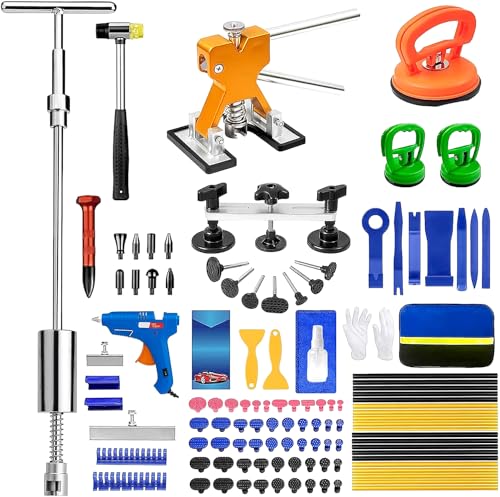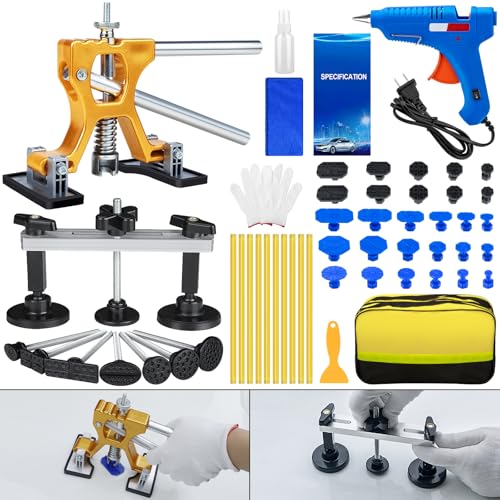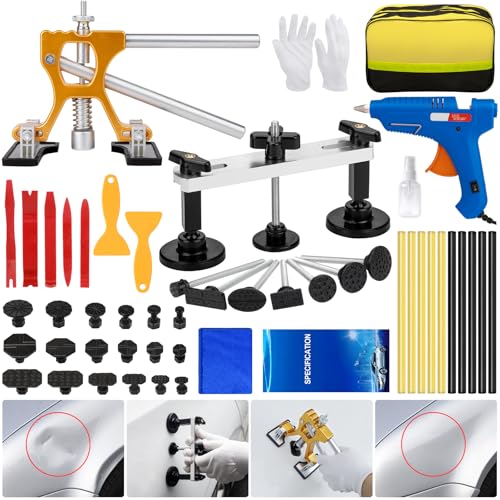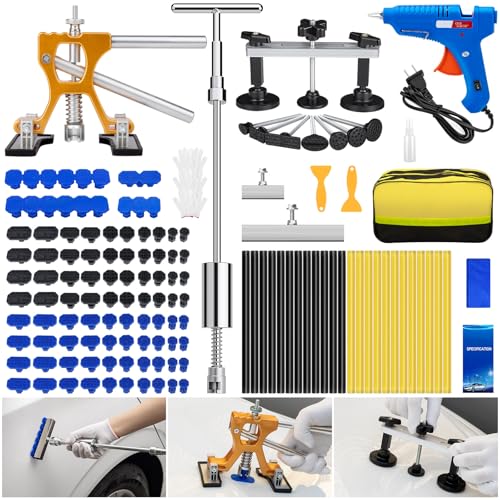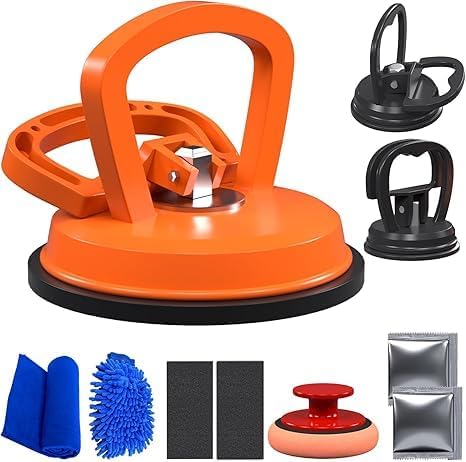That sinking feeling when you walk back to your car and spot a new, glaring dent is universal. Your immediate next thought is almost always the same: how much is this going to cost? The world of auto body repair can seem opaque, with prices that feel unpredictable. You’re left wondering if it’s a simple fix or a major expense, and whether it’s even worth repairing at all.
A small, paint-free dent can cost as little as $50-$150 to fix with PDR, while a large dent with paint damage requiring traditional bodywork can cost $1,000 to $4,000 or more. This significant range is why understanding the key cost factors is so critical.
This guide unpacks all the variables that determine your final bill, leveraging extensive analysis of industry data and established repair patterns. We will break down the different repair methods, provide data-backed cost estimates for various scenarios, and give you the knowledge to get a fair and accurate quote. This will help you effectively navigate how much to fix a dent in a car and make the best decision for your vehicle and your wallet.
Key Facts
- Wide Cost Spectrum: The price to fix a car dent has an exceptionally broad range, from as little as $50 for a minor paintless repair to over $4,000 for significant damage, as highlighted by data from sources like Chase.com and professional collision centers.
- Paint is the Deciding Factor: Whether the paint is scratched or intact is the single most important variable. A dent with broken paint can easily cost 2-5 times more to repair than an identical dent with the paint undamaged.
- Location Matters Immensely: A dent on a flat, accessible panel like the middle of a door is the cheapest to fix. Dents located on complex body lines, panel edges, or made of aluminum can double the repair cost due to increased difficulty and labor.
- PDR is the Gold Standard for Minor Dents: Paintless Dent Repair (PDR) is the preferred method for dents without paint damage, typically costing between $75 and $250 for a simple ding and preserving the car’s original factory finish.
- Multiple Quotes are Non-Negotiable: Due to variations in labor rates and shop overhead, getting at least three in-person estimates from reputable shops is the most effective way to ensure a fair price for your dent repair.
Car Dent Repair Costs: A 2025 Guide to Pricing
That sinking feeling when you spot a new dent is universal, but the cost to fix it doesn’t have to be a mystery. Here’s a quick look at what to expect. A small, paint-free dent can cost as little as $50-$150 to fix with PDR, while a large dent with paint damage requiring traditional bodywork can cost $1,000 to $4,000 or more.
The method used to repair the dent is the primary driver of the overall cost. Here is a summary of the typical price ranges you can anticipate, based on synthesized data from multiple automotive repair authorities.
| Dent Type / Repair Method | Typical Cost Range | Best For… |
|---|---|---|
| Paintless Dent Repair (PDR) | $50 – $500 | Small to medium dents (1-4 inches) where the paint is completely intact. Ideal for door dings and hail damage. |
| Traditional Dent Repair (Minor) | $150 – $1,000 | Medium-sized dents that have also caused scratches or chips in the paint, requiring filling, sanding, and repainting. |
| Traditional Dent Repair (Major) | $1,000 – $4,000+ | Large, deep, or complex dents, often from a collision, that require extensive bodywork and repainting of one or more panels. |
| Panel Replacement | $1,000 – $3,500+ | Severe damage where the panel (e.g., door, fender) is too stretched or complex to repair effectively. |
The 6 Key Factors That Determine Your Dent Repair Bill
The primary factors driving cost are the dent’s size, depth, and location; whether the paint is damaged; the repair method used; the vehicle’s make and material (e.g., aluminum); and local labor rates. Understanding these variables empowers you to understand any quote you receive and to know what to look for when assessing the damage yourself.
Here’s the deal: not all dents are created equal. A tiny door ding is a completely different challenge than a large crease across a body line. Let’s break down exactly what the professionals are looking at when they prepare your estimate.
Pro Tip: Before getting a quote, inspect the dent closely. Is the paint broken? Is it on a sharp body crease? Knowing these details will help you understand the estimate you receive.
- Dent Characteristics (Size, Depth, Location): The physical nature of the dent is the foundation of the repair cost. A small, shallow ding is a quick job; a large, deep crease is a project.
- Paint Condition: This is the great divider. If the paint is intact, a cheaper, faster repair is possible. If it’s chipped or scratched, the cost and time required increase dramatically.
- Repair Method: The choice between Paintless Dent Repair (PDR) and traditional bodywork is dictated by the paint’s condition and the dent’s severity. This is the biggest fork in the road for your final bill.
- Vehicle Panel Material: Standard steel is the baseline. If your car has aluminum or high-strength steel panels, expect the cost to be higher due to the specialized tools and skills required.
- Vehicle Make and Model: Luxury and high-end vehicles often have more complex designs, more expensive parts, and require more labor to disassemble for access, all of which drive up the price.
- Shop Labor Rates: Costs vary significantly based on your geographic location and the type of shop you choose (e.g., a dealership versus an independent body shop).
Dents on body lines or curved areas are always more complex and costly. These locations require significantly more skill to reshape correctly without distorting the panel, making them more labor-intensive than dents on flat surfaces.
1. Dent Characteristics: Size, Depth, and Location
A small, shallow dent on a flat panel is the cheapest to fix, while a large, deep dent on a complex body line significantly increases repair cost and difficulty. The size of the dent is the first thing an estimator will measure. Dents are often categorized by their diameter, but their depth and location are just as important.
Here’s how different types of dents, commonly seen in repair shops, stack up in terms of complexity:
- Hail dings: Typically small (less than 1 inch), shallow, but numerous. Cost is driven by the sheer quantity of dents across multiple panels.
- Shopping cart or door dings: Often 1-3 inches in diameter and of medium depth. The key factor here is whether the impact was hard enough to scratch or chip the paint.
- Minor collision damage: Can create large, deep dents (over 3-4 inches) that stretch the metal and almost always involve paint damage, making them much more complex and expensive to repair.
- Creases: These are long, sharp dents that are much more difficult to repair than round dents, as they require meticulous work to restore the body line’s crispness.
2. Paint Condition: The Major Cost Multiplier
If a dent has scratched or chipped paint, the cost increases significantly as the repair now requires sanding, filling, priming, and repainting, not just dent removal. This distinction is the most critical element in determining your final bill because it dictates the entire repair process.
Think of it this way: if the paint is intact, the goal is to push. If the paint is broken, the goal is to rebuild.
When the paint layer is compromised, a simple PDR fix is no longer an option. The repair becomes a multi-stage process that is far more labor-intensive and requires more materials. The necessary steps include:
- Sanding: The damaged area must be sanded down to the bare metal to remove the old paint and create a surface for the filler to adhere to.
- Filling: A body filler is applied to fill the depression and is skillfully shaped to match the original contour of the car’s body panel.
- Priming: Multiple coats of primer are applied over the filler to seal it, protect against rust, and create a smooth base for the new paint.
- Paint Matching: Using your vehicle’s paint code, the technician mixes a new batch of paint to match your car’s color and finish perfectly.
- Repainting & Blending: The area is repainted, and the new paint is often “blended” into the surrounding original paint to ensure a seamless, invisible transition.
- Clear Coat: A final clear coat is applied to protect the new paint and match the factory gloss.
Each of these steps adds significant time and material costs to the job, easily turning a $150 PDR fix into a $500+ traditional repair.
PDR vs. Traditional Repair: Choosing the Right Method
Paintless Dent Repair (PDR) is a cheaper, faster method for dents with intact paint, while Traditional Repair is necessary for larger dents or any damage involving scratches, requiring costlier bodywork and repainting. Knowing which category your dent falls into is the key to anticipating your repair cost.
So, which path is your dent likely to go down? Let’s break it down.
This table provides a clear comparison to help you understand the two primary methods for fixing a dent in a car.
| Category | Paintless Dent Repair (PDR) | Traditional Dent Repair |
|---|---|---|
| Best For | Small to medium dents (up to 4 inches), dings, and hail damage where the paint is not broken. | Larger, deeper, or complex dents, or any dent where the paint is scratched, chipped, or cracked. |
| Process | Specialized tools are used to access the back of the panel and gently massage the metal back to its original shape. | The area is sanded, filled with body filler, primed, and then the entire panel is often repainted and clear-coated. |
| Average Cost | $50 – $500 | $200 – $3,000+ |
| Time Required | 1 – 3 hours | 1 – 5 days |
| Effect on Original Finish | Preserves the factory paint and finish, which is ideal for maintaining vehicle value. | Replaces the factory finish with a new paint job on the affected area. High-quality work is undetectable. |
| Environmental Impact | Eco-friendly; no chemicals, fillers, or paints are used. | Involves paints, solvents, and other materials, giving it a higher environmental impact. |
How Much to Fix a Dent in a Car: Cost Breakdowns by Type
Expect to pay $50-$250 for a minor PDR fix, $300-$1,000 for a medium traditional repair with paint, and $1,000-$4,000+ for significant damage requiring extensive bodywork or panel replacement. To give you a more precise idea of what you might pay, we’ve broken down the costs based on repair type and dent severity, citing data from authoritative sources like Chase.com and professional PDR estimators.
Quick Fact: A cluster of hail dents can sometimes cost more to fix than a single large dent, with repairs potentially reaching $15,000 in severe cases. Analysis shows hail damage repair costs can range from $195 to as much as $2,200 per panel.
Cost of Paintless Dent Repair (PDR)
A single, small PDR repair typically costs $75-$165, but can rise to $1,500 for complex dents on aluminum panels, while hail damage can range from $500 to over $15,000. This method is priced based on the size, location, and accessibility of the dent.
Here are the typical cost tiers for PDR:
- $75 – $165: This is the common starting range for a single, simple dent under 1-2 inches on an easily accessible steel panel, like the middle of a door.
- $300 – $500: For a medium-sized dent (around 3-4 inches) or a smaller dent in a more difficult location, such as close to a panel edge.
- $300 – $1,500: This range covers larger or more complex PDR work. Factors that push the cost up include dents on aluminum panels (which are harder to work with), dents on sharp body lines that require extreme precision, or dents that require removing interior trim or other parts for access.
- $500 – $15,000+: This wide range is for hail damage. The cost is calculated based on the number and size of dents per panel. A car with light hail damage might be $500-$2,500, while a vehicle severely damaged by large hailstones could easily exceed $15,000, often leading to an insurance write-off.
Cost of Traditional Dent Repair (With Paint)
Traditional dent repair involving paintwork starts around $150-$1,000 for medium damage and can easily exceed $2,000-$4,000 for complex repairs on multiple panels or luxury vehicles. Once painting is required, the labor and material costs escalate quickly.
Here’s what you can expect for repairs that break the paint barrier:
- $150 – $1,000: This covers a minor to medium-sized dent where a small area needs to be filled, sanded, and repainted. An example would be a moderate parking lot dent with a deep scratch.
- $1,000 – $4,000+: This is the range for significant damage. This could involve a large dent from a collision, damage that crosses multiple body panels, or dents that require a full panel replacement.
- $1,500 – $2,000+: A common real-world scenario is a significant dent that damages both a door and the adjacent quarter panel. This repair is complex because it requires work and repainting across two separate parts of the car, with careful blending to ensure a perfect match.
- $3,500+: This price point is often associated with significant damage to luxury vehicles (like Lexus, BMW, Mercedes) or cars with specialty paints or materials. The high cost is due to more expensive parts, advanced sensor recalibration, and higher labor rates.
For those considering a hands-on approach for very minor dings, having the right equipment is crucial. A quality DIY dent repair kit can be a cost-effective first step for the smallest, most accessible dents.
Is It Worth Getting Dents Out of a Car?
Yes, it is often worth fixing dents to prevent a negative impact on your car’s resale or trade-in value, especially if the repair cost is less than your insurance deductible or the potential value loss. While it may be tempting to ignore a small dent, it can be a financially short-sighted decision.
Consider this: will the cost of the repair be less than the amount a buyer would try to knock off the price for that same dent? Often, the answer is yes. A prospective buyer sees a dent not just as a cosmetic flaw, but as a sign of neglect, and may use it to negotiate a much larger discount than the actual repair cost.
Here are the key points to weigh when making your decision:
- 1. Cost vs. Insurance Deductible: Most minor dents cost between $75 and $500 to fix. If your insurance deductible is $500 or $1,000, it’s almost always cheaper and smarter to pay for the repair out-of-pocket. This avoids filing a claim that could potentially raise your future premiums.
- 2. Impact on Resale Value: A clean, dent-free car will always command a higher price than one with visible body damage. Evidence suggests that fixing dents, even small ones, provides a strong return on investment when you sell or trade in your vehicle.
- 3. Preventing Further Damage: A dent with chipped paint can expose the underlying metal to moisture, leading to rust. A small, inexpensive repair today can prevent a much larger, more expensive rust problem down the road.
- 4. Aesthetic Preference: For many car owners, the decision is simple. They take pride in their vehicle’s appearance and want to keep it looking its best.
Fixing even a small dent is often a worthwhile investment to maintain your car’s aesthetic appeal and protect its resale value.
How to Get an Accurate and Fair Dent Repair Estimate
To get the best price, obtain at least three in-person estimates from different reputable auto body shops or PDR specialists to compare not just cost, but also the proposed repair method and warranty. Because pricing can vary significantly from one shop to another, doing your homework is the single most effective way to avoid overpaying.
Don’t just go with the first quote you get. Follow these simple steps to ensure you’re getting quality work at a fair price.
Pro Tip: Many reputable shops offer free quotes. Don’t feel pressured to commit on the spot; your goal is to gather information.
- Find Reputable Local Shops: Start by searching for well-reviewed auto body shops and PDR specialists in your area. Look for businesses with a strong track record, positive customer testimonials, and certifications from automotive industry groups.
- Get at Least Three In-Person Estimates: An estimate over the phone or based on a photo is never fully accurate. The technician needs to see the dent in person to assess its depth, check for hidden damage, and determine if the panel is steel or aluminum.
- Ask About Their Process and Warranty: When you get a quote, ask the technician to walk you through their proposed repair plan. Will they use PDR or traditional methods? What is their process for paint matching? Do they offer a warranty on their workmanship and the paint finish? A reputable shop will be happy to explain their process.
- Compare Services, Not Just Price: The cheapest quote is not always the best one. One shop might be proposing a quick, cheap fix while another proposes a more thorough repair that will last longer. Compare the details of each estimate to ensure you’re making an apples-to-apples comparison of the value being offered.
FAQs About How Much to Fix a Dent in a Car
How much does it cost to get a simple dent out of a car?
For a simple, small dent (1-2 inches) with no paint damage, you can expect to pay between $75 and $250 for a professional Paintless Dent Repair (PDR) service. This is one of the most common and affordable types of repair, perfect for minor door dings or impacts from small objects where the factory paint is still intact.
Is it worth getting minor dents out of a car?
Yes, it is usually worth fixing minor dents. The cost is relatively low (often under $250) and it preserves your car’s aesthetic and resale value, preventing potential buyers from devaluing your car by a larger amount. Fixing them also prevents potential rust issues if there are any micro-cracks in the paint not visible to the naked eye.
How much more does it cost to fix a dent with a scratch?
A scratch dramatically increases the cost. While a paint-free dent might be $150, the same dent with a scratch could cost $300 to $1,000 or more because it requires a traditional repair involving sanding, filling, and repainting the panel. The added labor and materials for the multi-step paint process are what drive the significant price increase.
How much does it cost to fix a dent on a car door?
A minor dent on a car door can cost $75-$250 for PDR. However, a larger dent requiring traditional repair and repainting could cost $1,500 to $2,000 or more, especially if it affects body lines or internal electronics. The door is a complex panel containing window mechanisms and wiring, and damage to its structural lines can make repairs more labor-intensive.
Should I use my insurance to fix a car dent?
Only consider using insurance if the repair cost is significantly higher than your deductible. For most minor dents ($50-$500), it is cheaper to pay out-of-pocket to avoid a potential increase in your insurance premiums. If the damage is from a major collision and the estimate is in the thousands, then using your comprehensive or collision coverage is appropriate.
Final Summary: Making the Right Call on Your Car Dent Repair
Figuring out how much to fix a dent in a car comes down to a clear, logical assessment of the damage. While the potential cost can seem daunting, it becomes manageable once you understand the key variables at play. The size of the dent, the location, and above all, the condition of the paint are what will steer the cost from a minor expense to a major repair.
Armed with this knowledge, you can now confidently assess your dent, understand the potential costs, and find a fair price for a quality repair.
Here are the most critical takeaways to remember:
- Assess the Paint First: The very first thing to check is if the paint is scratched or chipped. This is the single biggest factor that determines whether you’re looking at an inexpensive PDR fix or a more costly traditional repair.
- PDR is Your Best Friend: For dents without paint damage, Paintless Dent Repair is the fastest, cheapest, and best method for preserving your car’s value.
- Get Multiple In-Person Quotes: Don’t settle for the first price you’re given. Taking the time to get at least three estimates from reputable shops is the surest way to get a fair price and avoid overpaying.
- Consider the Resale Value: Fixing dents is an investment in your vehicle’s value. The cost of the repair is almost always less than the amount a potential buyer will try to deduct from your asking price.
By following this data-driven approach, you can take control of the repair process, make an informed financial decision, and get your car looking its best again without breaking the bank.
Last update on 2025-10-24 / Affiliate links / Images from Amazon Product Advertising API
